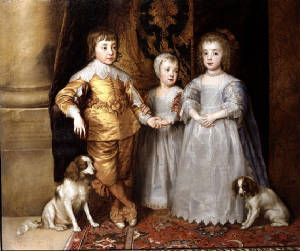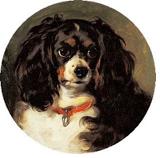|
1500's - Henry
VIII was not known as a dog lover and decreed, during his reign, that no dogs should be kept at court except for “some
small spanyells for the ladies”. In 1554 a portrait was painted of his daughter, Queen Mary I and her husband, Philip
of Spain, with a pair of toy spaniels at their feet. In 1570 Dr,
Johannes Caius, chief physician to Queen Elizabeth I, wrote a Latin treatise which divided the known breeds of dogs in England
into five groups. The third group was for “Spaniell gentle or comforter - a delicate, neat and pretty kind of dog”.
He also described them as “chamber companions” and “pleasant play fellows” and wrote that the small
spaniels could relieve pain and discomfort when held against the stomach or chest of a diseased or weak person. Be that as
it may, the small spaniels were certainly often carried for warmth and companionship. There is also the well known story of
a small black and white spaniel which was found under the petticoats of Mary, Queen of Scots, after her execution at Fotheringay
Castle in 1587. The record of the story tells that the spaniel was covered in blood and was taken away and washed.

|
| King Charles II as a child with Cavaliers |
1600's - Charles II grew up with toy spaniels and is pictured as a child with his brother and
sister and two toy spaniels in a painting by Van Dyke. He also brought some back to England with him on his return from exile
in 1660. The small spaniels became his special favourites, so much so that he was rarely seen without them - a fact not always
appreciated by those in court! According to diarist, John Evelyn, the King “took great delight in having a number of
little spaniels follow him and lie in his bed chamber where he suffered the bitches to puppy, which rendered it very offensive
and indeed, the whole court stinking”.

|
| Dash |
1800's - Queen Victoria - Queen Victoria had a favourite Toy Spaniel called Dash, and artist,
Sir Edwin Landseer’s first royal commission was a delightful head study of Dash, painted in 1836. He also painted Queen
Victoria’s second toy spaniel, a black and tan called Tilco. Dash was Victoria's faithful companion throughout her secluded
girlhood and early reign and was regularly mentioned in her personal diary. It is said that following her coronation in 1837
she hurried back to her apartments to give Dash his evening bath.Dash also played a part in bringing Victoria and Albert together.On
their first meeting Victoria was taken with the tall, serious blue eyed Albert,but it was his behaviour toward Dash which
sealed her approval of him. She recorded in her diary that”Albert played with and fussed over Dash. Dash is buried in
the grounds of Windsor Castle and his epitaph reads” His attachment was without selfishness, His playfulness without
malice, His fidelity without deceit. Reader if you would live beloved and die regretted, profit example of Dash”

|
| The Marlborough's |
1800’S - The Marlborough's - The Duke and Duchess of Marlborough
were great lovers of the small spaniels and the Duke is credited with being the first in Britain to breed small spaniels with
the red and white colouring. Blenheim Palace was the ancestral home of the Marlboroughs; thus the red and white (or chestnut
and white) spaniels became known as ‘Blenheim Spaniels’ and the name Blenheim has remained. A well known story
about Sarah, Duchess of Marlborough is said to explain the origin of the lozenge or spot which appears on the head of some
blenheims.It is said that Sarah continually pressed the head of a pregnant bitch to calm her nerves as the bitch sat faithfully
beside her.comforting her while she awaited anxiously for news of the Duke who was fighting in the Battle of Blenheim.When
the bitch gave birth, each of the puppies carried a thumbprint (said to be a sign of faithfulness) on their heads.
Author Unknown
|



